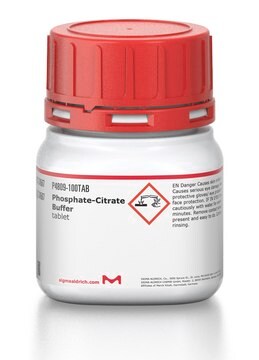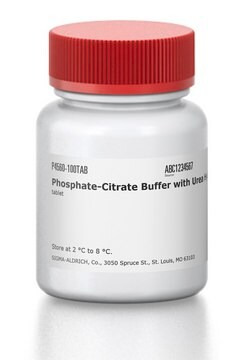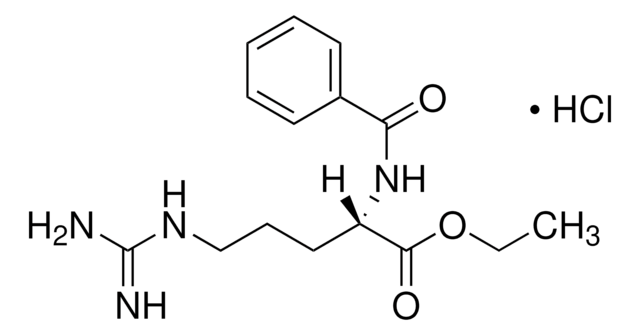T7677
L-Tyrosine Decarboxylase from Streptococcus faecalis
≥0.1 unit/mg solid
Synonyme(s) :
L-Tyrosine carboxy-lyase
Se connecterpour consulter vos tarifs contractuels et ceux de votre entreprise/organisme
About This Item
Produits recommandés
Vous recherchez des produits similaires ? Visite Guide de comparaison des produits
Application
L-Tyrosine decarboxylase from Streptococcus faecalis has been used in a study to isolate and identify the carbonyl-active site of diamine oxidase by gas chromatographic mass spectrometry. L-Tyrosine decarboxylase from Streptococcus faecalis has also been used in a study to investigate the adsorption of Streptococcus faecalis on diatomite carriers for use in biotransformations.
Autres remarques
Dried cells from which activity can be extracted.
Définition de l'unité
One unit will cause the decomposition of 1.0 μmole of L-tyrosine per min at pH 6.2 at 37 °C.
Code de la classe de stockage
11 - Combustible Solids
Classe de danger pour l'eau (WGK)
WGK 3
Point d'éclair (°F)
Not applicable
Point d'éclair (°C)
Not applicable
Équipement de protection individuelle
Eyeshields, Gloves, type N95 (US)
Faites votre choix parmi les versions les plus récentes :
Déjà en possession de ce produit ?
Retrouvez la documentation relative aux produits que vous avez récemment achetés dans la Bibliothèque de documents.
W A Anderson et al.
Journal of chemical technology and biotechnology (Oxford, Oxfordshire : 1986), 47(2), 93-100 (1990-01-01)
Adsorption of cells on particulate carriers is potentially one of the most cost-effective immobilization techniques available. Diatomite carriers, such as Celite, have desirable physical properties, are inexpensive, and are suitable for both mycelial and bacterial systems. This work investigated the
F Buffoni
Analytical biochemistry, 220(1), 185-191 (1994-07-01)
An adduct with phenylhydrazine was formed with the purified pig kidney diamine oxidase and in parallel with the l-tyrosine decarboxylase from Streptococcus faecalis. The labeled enzymes were hydrolyzed by chemical hydrolysis and the adducts released by hydrolysis were isolated and
Characterization of bacterial L-(-)-tyrosine decarboxylase by isoelectric focusing and gel chromatography
Allenmark, C. and B. Servenius
Journal of Chromatography A, 153, 238-245 (1978)
Daniel M Linares et al.
Microbial biotechnology, 2(6), 625-633 (2009-11-01)
The microbial decarboxylation of some amino acids leads to the undesirable presence of biogenic amines in foods. One of the most abundant and frequent biogenic amines found in fermented foods is tyramine, which is produced by the decarboxylation of tyrosine.
Nicole Tanz et al.
Journal of agricultural and food chemistry, 59(17), 9475-9483 (2011-07-12)
The δ(18)O value of the p-hydroxy group of L-tyrosine depends on the biosynthesis by plants or animals, respectively. In animal proteins it reflects the diet and is therefore an absolute indicator for illegal feeding with meat and bone meal. The
Notre équipe de scientifiques dispose d'une expérience dans tous les secteurs de la recherche, notamment en sciences de la vie, science des matériaux, synthèse chimique, chromatographie, analyse et dans de nombreux autres domaines..
Contacter notre Service technique








